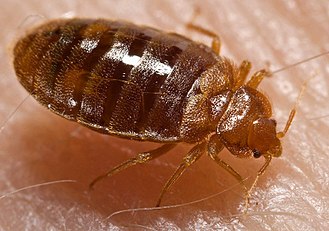Cimex

Cimex is a genus of insects in the family Cimicidae.[1] Cimex species are ectoparasites that typically feed on the blood of birds and mammals. Two species, Cimex lectularius and Cimex hemipterus, are known as bed bugs and frequently feed on humans, although other species may parasitize humans opportunistically.[2] Species that primarily parasitize bats are known as bat bugs.
The insects are 3 to 9 millimetres (0.12 to 0.35 in) long and have flattened reddish-brown bodies with small nonfunctional wings.\
Adult Cimex are light brown to reddish-brown, flat and oval. The mouthparts are beak-like, and adapted for piercing and sucking. Following a blood meal the abdomen is plump and darker in colour. The front wings are vestigial and reduced to pad-like structures and there are no hind wings. Cimex have segmented abdomens with microscopic hairs that give them a banded appearance. Adults grow to 3 to 9 mm (0.12 to 0.35 in) long. The different species are very similar in morphology and can only be separated by microscopic examination.[1][3] Sexual dimorphism occurs in C. lectularius, with the females larger in size than the males on average. The abdomens of the sexes differ in that the males appear to have “pointed” abdomens, which are actually their copulatory organs, while females have more rounded abdomens.[4]
Newly hatched nymphs are translucent, light in color at first, becoming browner as they moult and approach maturity. A Cimex nymph of any age that has just consumed a blood meal has a bright red, translucent abdomen, fading to brown over the next several hours, and to opaque black within two days as the insect digests its meal.[3] Cimex may be mistaken for other insects, such as booklice, small cockroaches, or carpet beetles; however, when warm and active, their movements are more ant-like, and like most other true bugs, they emit a characteristic disagreeable odor when crushed.
Cimex use pheromones and kairomones to communicate regarding nesting locations, feeding, and reproduction.
The lifespan of Cimex varies by species and is also dependent on feeding.
